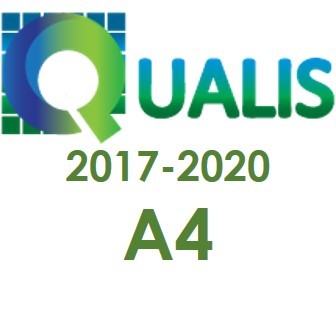Efeitos do Echinodorus grandiflorus com potencial para o tratamento da artrite reumatoide
tratamento alternativo para doenças reumatológicas
Palavras-chave:
Alimastaceae, Artrite reumatoide, Anti-inflamatórios, Doenças cardiovascularesResumo
O Equinodorus grandiflorus (EGF) é uma planta medicinal encontrada em todo Brasil e popularmente utilizada como diurético e anti-inflamatório. Esses efeitos a tornam promissora para tratamento da artrite reumatóide (AR), uma doença inflamatória crônica das articulações sinoviais freqüentemente associada a doenças cardiovasculares. Essa revisão narrativa descreveu as evidências de estudos que mostraram que extratos do ECG têm efeito antiinflamatório em modelos experimentais de inflamação aguda, além de efeito diurético, analgésico, vasodilatador e dislipidêmico também em animais experimentais. No entanto, ainda faltam estudos em modelos experimentais que reproduzam melhor a AR e ensaios clínicos.
Downloads
Referências
AGÊNCIA NACIONAL DE VIGILÂNCIA SANITÁRIA (ANVISA). Plantas Medicinais, PM 033-00. In AGÊNCIA NACIONAL DE VIGILÂNCIA SANITÁRIA (ANVISA). Farmacopeia Brasileira. 6 ed. Brasília, DF, 2019, v.2. Disponível em: <https://www.gov.br/anvisa/pt-br/assuntos/farmacopeia/farmacopeia-brasileira>. Acesso em: 25 ago. 2022.
ASQUITH, D.L.et al. Animal models of rheumatoid arthritis. Eur J Immunol., v.39, n.8, p. 2040- 2044, 2009. DOI: https://doi.org/10.1002/eji.200939578. Disponível em: . Acesso em: 31 ago. 2022.
ATZENI, F. et al. Publisher Correction: Cardiovascular effects of approved drugs for rheumatoid arthritis. Nat Rev Rheumatol., v.17, n.5, p.306, 2021. Erratum for: Nat Rev Rheumatol.; v.17, n.5, p.270-290, 2021. DOI: https://doi.org/10.1038/s41584-021-00593-3.
BUERMESTER, G.R. et al. ORAL Step investigators. Tofacitinib (CP-690,550) in combination with methotrexate in patients with active rheumatoid arthritis with an inadequate response to tumour necrosis factor inhibitors: a randomised phase 3 trial. Lancet, v. 9, n.381(9865), p.451-460, 2013. DOI:https://doi.org/10.1016/S0140-6736(12)61424-X.
CAMPANA, P.R. et al. Anti-TNF-α Activity of Brazilian Medicinal Plants and Compounds from Ourateasemiserrata. Phytother Res., v.29, n.10, p.1509-1515, 2015. DOI: https://doi.org/10.1002/ptr.5401.
COSTA, M.et al. Isolation And Synthesis Of a new Clerodane from Echinodorusgrandiflorus, Phytochemistry, v.50, n.1, p.117-122, 1999.
COSTELLO, R. E. et al. Glucocorticoid use is associated with an increased risk of hypertension. Rheumatology (Oxford, England), v. 60, n.1, p.132–139, 2021. DOI: https://doi.org/10.1093/rheumatology/keaa209.Disponívelem: . Acesso em: 31 ago. 2022.
DA SILVA, C. J.; BASTOS, J. K.; TAKAHASHI, C. S. Evaluation of the genotoxic and cytotoxic effects of crude extracts of Cordiaecalyculata and Echinodorusgrandiflorus. Journal of ethnopharmacology, v. 127, n. 2, p. 445-450, 2010. DOI: https://doi.org/10.1016/j.jep.2009.10.015. Disponívelem: . Acesso em: 31 ago. 2022.
DE CARVALHO et al. Endothelium-Dependent Effects of Echinodorusgrandiflorus (Cham. &Schltdl.) Micheli Mediated by M3-Muscarinic and B2-Bradykininergic Receptors on Peripheral Vascular Resistance and Its Modulatory Effects on K+ Channels in Mesenteric Vascular Beds. Evidence-based complementary and Alternat Med., v. 2019; n. 4109810, 11p, 2019. DOI: https://doi.org/10.1155/2019/4109810.Disponívelem: . Acesso em: 31 ago. 2022.
DE OLIVEIRA D.P et al. Cis-AconiticAcid, a ConstituentofEchinodorusgrandiflorus Leaves, Inhibits Antigen-Induced Arthritis and Gout in Mice. Planta Med., 2021. Publicação online antes da impressa. DOI: https://doi.org/10.1055/a-1676-4371.
DUTRA, R. C. et al. Investigação das atividades analgésica e antiinflamatória do extrato metanólico dos rizomas de Echinodorusgrandiflorus.Revista Brasileira de Farmacognosia [online], v. 16, n. 4 pp. 469-474, 2007. DOI:https://doi.org/10.1590/S0102-695X2006000400005. Disponível em: . Acesso em: 31 ago. 2022.
EKOR, M. The growing use of herbal medicines: issues relating to adverse reactions and challenges in monitoring safety. Frontiers in pharmacology, v. 4, p. 177, 2014. DOI:https://doi.org/10.3389/fphar.2013.00177.Disponívelem: .Acessoem: 31 ago. 2022.
FERNÁNDEZ-LLANIO COMELLA, N., FERNÁNDEZ MATILLA, M.; CASTELLANO CUESTA, J. A. Have complementary therapies demonstrated effectiveness in rheumatoid arthritis?.Reumatologia clinica, v. 3, n. 12, p. 151–157, 2016. DOI: https://doi.org/10.1016/j.reuma.2015.10.011. Disponível em: . Acesso em: 31 ago. 2022.
GARCIA E. F. et al. Antiedematogenic activity and phytochemical composition of preparations from Echinodorusgrandiflorus leaves. Phytomedicine., v. 18, n. 1, p. 80-6, 2010. DOI: https://doi.org/10.1016/j.phymed.2010.05.008. Disponívelem: . Acesso em: 31 ago. 2022.
GARCIA, E. et al. Effect of the Hydroethanolic Extract from Echinodorusgrandiflorus Leaves and a Fraction Enriched in Flavone-C-Glycosides on Antigen-Induced Arthritis in Mice. Planta Med, v.82, n.5, p.407–413, 2016b. DOI: https://doi.org/10.1055/s-0035-1568200.
GARCIA, E. F. et al. In Vitro TNF-α Inhibition Elicited by Extracts from Echinodorusgrandiflorus Leaves and Correlation with Their Phytochemical Composition. Planta Med., v.82, n.4, p.337-43, 2016a. DOI: https://doi.org/10.1055/s-0035-1558290.
GASPAROTTO, F.M. et al. Heart-protective effects of Echinodorusgrandiflorus in rabbits that are fed a high-cholesterol diet. Planta Med., v. 84, p. 1271-1279, 2018. DOI: https://doi.org/10.1055/a-0644-2794.
GASPAROTTO, F. M. et al. Antiatherosclerotic properties of Echinodorusgrandiflorus (Cham. &Schltdl.) Micheli: from antioxidant and lipid-lowering effects to an anti-inflammatory role. Journal of medicinal food, v. 22, n. 9, p. 919-927, 2019. DOI: https://doi.org/10.1089/jmf.2019.0017.
GHOSH, R.; ALAJBEGOVIC, A.; GOMES, A.V. NSAIDs and Cardiovascular Diseases: Role of Reactive Oxygen Species. Oxid Med Cell Longev., v. 2015, p. 536- 962, 2019. DOI: https://doi.org/10.1155/2015/536962.
GIANNINI, D. et al. One year in review 2020: pathogenesis of rheumatoid arthritis. ClinExpRheumatol, V.38, n.3, p.387-397, May-Jun 2020. PMID: 32324123. Disponívelem: . Acesso em: 2 set. 2022.
GOMES, F. et al. Microvascular Effects of Echinodorusgrandiflorus on Cardiovascular Disorders. Planta Med., v. 86, n. 6, p.395-404, 2020. DOI: https://doi.org/10.1055/a-1118-9341.
KRABBE, S. et al. Risk of serious infections in arthritis patients treated with biological drugs: a matched cohort study and development of prediction model. Rheumatology (Oxford, England), v.60, n.8, p.3834–3844, 2021. DOI: https://doi.org/10.1093/rheumatology/keaa876.
LACAILLE, D. et al. Improvement in 5-year mortality in incident rheumatoid arthritis compared with the general population-closing the mortality gap. Annals of the rheumatic diseases, v.76, n.6, p.1057–1063, 2017.DOI:https://doi.org/10.1136/annrheumdis-2016-209562. Disponível em: . Acesso em: 31 ago. 2022.
LESSA, M.A. et al. Antihypertensive effects of crude extracts from leaves of Echinodorusgrandiflorus. Fundam Clin Pharm., v. 22, p. 161–168. 2008. DOI: https://doi.org/10.1111/j.1472-8206.2008.00565.x.
LIAO, K.P.; SOLOMON, D.H. Traditional cardiovascular risk factors, inflammation and cardiovascular risk in rheumatoid arthritis. Rheumatology (Oxford), v.52, n.1, p.45-52, Jan 2013. DOI: https://doi.org/10.1093/rheumatology/kes243. Disponível em: . Acesso em: 31 ago. 2022.
LIMA-DELLAMORA, E.C.et al. Genotoxic Maillardbyproducts in current phytopharmaceutical preparations of Echinodorusgrandiflorus. An Acad Bras Cienc., v.86, n.3, p.1385-1394, 2014. DOI: https://doi.org/10.1590/0001-3765201420130065. Disponívelem: Echinodorusgrandiflorus Genotoxic Maillardbyproducts in current phytopharmaceutical preparations of Echinodorusgrandiflorus. Acesso em: 31 ago. 2022.
LIU, Y. et al. Extracts of Tripterygiumwilfordii Hook F in the Treatment of Rheumatoid Arthritis: A Systemic Review and Meta-Analysis of Randomised Controlled Trials.Evid Based Complement Alternat Med., v.2013, n.410793, 2013. DOI: https://doi.org/10.1155/2013/410793. Disponívelem: . Acesso em: 31 ago. 2022.
LORENZI, H.; MATOS, F.J.A. Plantas Medicinais no Brasil: nativas e exóticas, 2. ed. São Paulo: Editora Nova Odessa, Instituto Plantarum, 2008, 576 p. Echinodorusgrandiflorus (Cham. &Schltdl.) Micheli, p.42-43. ISBN 85-86714-28-3
LØGSTRUP, B.B. et al. Cardiovascular risk and mortality in rheumatoid arthritis compared with diabetes mellitus and the general population. Rheumatology (Oxford), v.60, n.3, p.1400-1409, 2021. DOI: https://doi.org/10.1093/rheumatology/keaa374.
MARQUES, A.M. et al. Echinodorusgrandiflorus: Ethnobotanical, phytochemical and pharmacological overview of a medicinal plant used in Brazil. Food ChemToxicol, v.109, n., p.1032-1047, 2017. DOI:https://doi.org/10.1016/j.fct.2017.03.026.
MCWILLIAMS, D.F.; WALSH, D.A. Pain mechanisms in rheumatoid arthritis. ClinExpRheumatol., v. 107. n. 5, p. 94-101, 2017.Disponívelem: . Acessoem: 2 set. 2022.
OLIVEIRA, D.P. et al. Encapsulation of trans-aconitic acid in mucoadhesive microspheres prolongs the anti-inflammatory effect in LPS-induced acute arthritis. Eur J Pharm Sci., v.119, p. 112-120, 2018a. DOI: https://doi.org/10.1016/j.ejps.2018.04.010.
OLIVEIRA, D.P. et al. Esterification of trans-aconitic acid improves its anti-inflammatory activity in LPS-induced acute arthritis. Biomed Pharmacother., v. 99, p. 87-95, 2018b. DOI: https://doi.org/10.1016/j.biopha.2018.01.009.
OLIVEIRA, R. A. de. Novasestratégias terapêuticas para o tratamento da artrite reumatoide:uma análise através de documentos de patentes. 2020. Tese (Doutorado em Propriedade Intelectual e Inovação) – Instituto Nacional da Propriedade Industrial, Rio de Janeiro, Rio de Janeiro, 2020. Disponível em: <https://www.gov.br/inpi/pt-br/servicos/academia/arquivo/teses/oliveira-rodrigo-ayres-de.pdf>. Acesso em: 25 ago. 2022.
PRANDO, T. B. et al. Ethnopharmacological investigation of the diuretic and hemodynamic properties of native species of the Brazilian biodiversity. Journal of ethnopharmacology, v.174, p.369–378, 2015. https://doi.org/10.1016/j.jep.2015.08.029. Disponível em Ethnopharmacological investigation of the diuretic and hemodynamic properties of native species of the Brazilian biodiversity - ScienceDirect. Acesso em 02/12/2022.
PRANDO, T. B. et al.Involvement of bradykinin B2 and muscarinic receptors in the prolonged diuretic and antihypertensive properties of Echinodorusgrandiflorus (Cham. &Schltdl.) Micheli. Phytomedicine, v. 23, n. 11, p. 1249-1258, 2016. DOI: https://doi.org/10.1016/j.phymed.2015.10.020. Disponívelem: . Acesso em: 31 ago. 2022.
RIBEIRO, R.A. et al. Acute diuretic effects in conscious rats produced by some medicinal plants used in the state of São Paulo, Brasil. Journal of ethnopharmacology, v.24, n.1, p.19–29, 1988 https://doi.org/10.1016/0378-8741(88)90136-5
RUPARELIA, N. et al. Inflammatory processes in cardiovascular disease: a route to targeted therapies. Nature ReviewsCardiology, v.14, n.3, p.133–144, 2017. DOI: https://doi.org/10.1038/nrcardio.2016.185. Disponívelem: . Acesso em: 31 ago. 2022.
SANTOS, R.R. et al. Fenologia e quimiodiversidade do ‘Chapéu-de-couro’ (Echinodorusgrandiflorus e Echinodorusmacrophyllus) / Phenologyandchemiodiversityofthe ’Chapéu-de-couro’ (Echinodorusgrandiflorus e Echinodorusmacrophyllus). Caderno De Ciências Agrárias, v. 9, n. 3, p. 115–118, 2017. Disponível em: . Acesso em: 2 set 2022.
SCHNITZLER, M.; PETEREIT, F.; NAHRSTEDT, A. Trans-Aconitic acid, glucosylflavones and hydroxycinnamoyltartaric acids from the leaves of Echinodorusgrandiflorus ssp. aureus, a Brazilian medicinal plant.Rev. bras. farmacogn., João Pessoa, v. 17, n. 2, p. 149-154, 2007 . DOI: https://doi.org/10.1590/S0102-695X2007000200002. Disponível em: . Acessado em: 2 set. 2022.
SIN SINGER BRUGIOLO, S. et al. Reproductive toxicity of Echinodorusgrandiflorus in pregnant rats. J Toxicol Sci. vol. 6, n. 35, p. 911-922, 2010. DOI: https://doi.org/10.2131/jts.35.911.Disponívelem: . Acesso em: 31 ago. 2022.
SMOLEN, J. S.; ALETAHA, D.; McINNES, I. B. Rheumatoid arthritis. Lancet, v. 388, n. 10055, p. 2023-2038, 2016. DOI: https://doi.org/10.1016/S0140-6736(16)30173-8.
STRADA, C.L. et al. Isovitexin as marker and bioactive compound in the antinociceptive activity of the Brazilian crude drug extracts of Echinodorusscaber and E. grandiflorus. Revista Brasileira de Farmacognosia [online]. v. 27, n. 5, p. 619-626, 2017 DOI:https://doi.org/10.1016/j.bjp.2017.05.011.Disponívelem: .Acesso em: 31 ago. 2022.
TIBIRIÇÁ, E. et al. Pharmacological mechanisms involved in the vasodilator effects of extracts from Echinodorusgrandiflorus. J Ethnopharmacol. v.111, p. 50-55, 2007. DOI: https://doi.org/10.1016/j.jep.2006.10.030.
VAN DER WOUDE, D. ; VAN DER HELMAN MIL, A. Update on the epidemiology, risk factors, and disease outcomes of rheumatoid arthritis. Best practice & Research Clinical Rheumatology, v. 32, n. 2, p. 174-187, 2018. DOI: https://doi.org/10.1016/j.berh.2018.10.005.
VIDAL, L. S. et al. Genotoxicity and mutagenicity of Echinodorusmacrophyllus (chapéu-de-couro) extracts. Genetics and Molecular Biology, v. 33, p. 549-557, 2010. DOI: https://doi.org/10.1590/S1415-47572010005000060. Disponívelem: . Acesso em: 31 ago. 2022.
YANG, C. L. et al.Scientific basis of botanical medicine as alternative remedies for rheumatoid arthritis. Clinical reviews in allergy & immunology, v.44, n.3, p.284–300, 2013. DOI: https://doi.org/10.1007/s12016-012-8329-8.
XIE, W. et al. Incident diabetes associated with hydroxychloroquine, methotrexate, biologics and glucocorticoids in rheumatoid arthritis: A systematic review and meta-analysis. Seminars in arthritis and rheumatism, v.50, n.4, p.598–607, 2020. DOI: https://doi.org/10.1016/j.semarthrit.2020.04.005.
Arquivos adicionais
Publicado
Como Citar
Edição
Seção
Licença
Copyright (c) 2022 Revista Brasileira de Iniciação Científica

Este trabalho está licenciado sob uma licença Creative Commons Attribution-NonCommercial-ShareAlike 4.0 International License.




